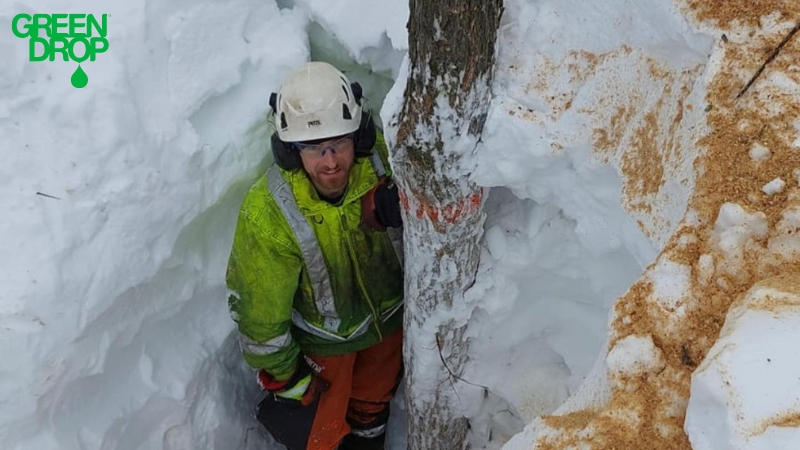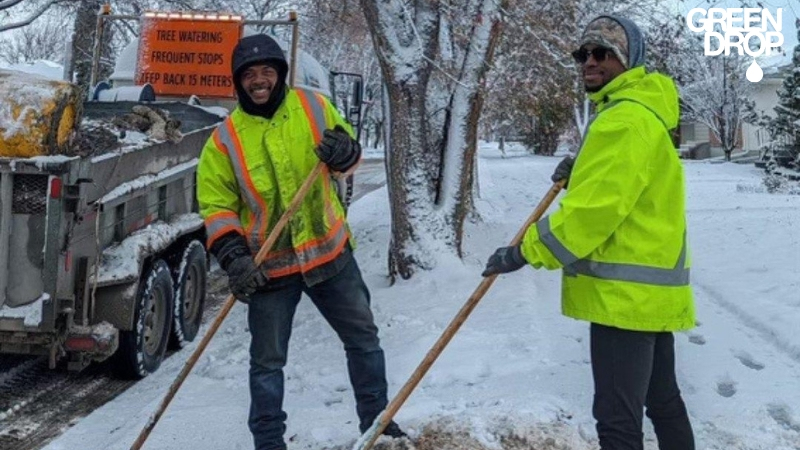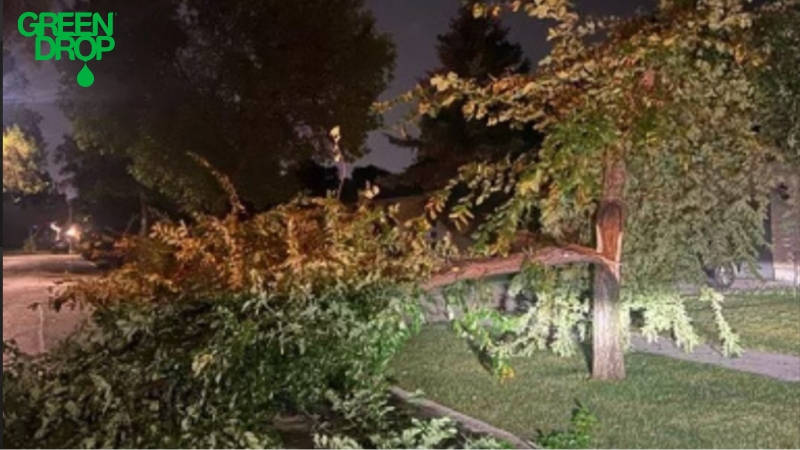Winter Woes: Managing Tree Emergencies in Regina During Snow and Ice Storms
Reading time: 6 minutesWinter in Regina is as much a test of resolve for our trees as it is for us. While we’re bundling up, creeping under blankets, and sipping hot cocoa, our trees are bracing themselves for the snow and ice storms about to roll in.
Winter is truly a survival game for our green giants, and they need all the help they can get! No matter how wild the winter gets, come spring, you want your trees standing strong.
So, let’s get through the next winter together with some tree-saving tips!

Common Winter Issues for Trees in Regina
1. Frost Cracks
Frost cracks are vertical fissures that occur when temperatures drop suddenly, causing the wood to contract faster than the bark. This results in a split that can be quite dramatic.
You can prevent frost cracks by wrapping the trunk with tree guards or plastic wraps in the fall. Young trees and thin-barked species like maples and cherries are especially vulnerable. So, give them a little extra TLC to keep them snug and crack-free.
2. Salt Damage
Road salt, while a necessity for Regina roads, can be a real pain for your trees. It leads to soil salination that sucks the moisture right out of plant roots. To mitigate salt damage, try using less corrosive alternatives like calcium chloride or sand for ice control near vegetation.
Additionally, water deeply before the ground freezes to help dilute salt accumulation. Also, installing physical barriers like burlap screens can protect trees from salt spray from passing cars.
3. Sunscald
This is an injury that occurs when a tree's bark warms up on sunny winter days, causing cells to come out of dormancy and become active. When the temperature drops quickly at sunset, these cells can die, leaving the tree with sunken, cracked, or peeling bark.
To protect your trees, wrap their trunks with tree wrap in late fall, which reflects sunlight and insulates the bark. Make sure to remove it come spring.
4. Ice Build-up and Broken Branches
Ice build-up during those notorious winter storms can be a real headache for your trees. When branches get loaded with ice, they're more likely to snap under the pressure.
The best way to prevent this is by giving your trees a good trim in the late fall. Remove any weak branches that might not handle the extra weight. For bigger or more complex trees, it might be wise to call in a professional arborist.
5. Frost Heaving
Frost heaving happens when the ground repeatedly freezes and thaws, pushing shallow roots upwards and out of the soil. This exposes roots to chilly winds that can dry them out.
To keep your trees firmly planted, mulch around their bases before the cold sets in. A cozy layer of mulch acts like a blanket, insulating the soil and roots. If the soil does push your plants up, gently press them back into place once it thaws. Remember, a well-mulched tree is a happy tree!
6. Root Damage
Winter is a rough time for tree roots. The frozen ground makes it hard for them to absorb water, and sharp temperature drops can damage them.
To protect the roots, water your trees deeply before the ground freezes. This gives them a good reserve of moisture. Also, avoid compacting the snow around the base of your trees since compacted snow can freeze harder, making it difficult for roots to breathe.
If you use de-icing salts, choose ones that are tree-friendly, or better yet, use alternatives like sand or kitty litter to prevent ice build-up without harming your roots.
7. Winter Burn
Ever noticed evergreens turning a sad shade of brown or red in winter? That’s winter burn. It happens because the sun and wind cause the tree to lose water faster than its frozen roots can replace it.
To protect your trees, consider wrapping them in burlap, especially on the side facing the wind and sun. This shields them from harsh elements.
Keep your trees well-watered in the fall, so they enter winter hydrated. A little prevention can keep your greens looking great, even in the greyest months.
8. Frost Damage
The coming of spring is a sign of glad tidings. However, frost damage can spoil the fun, with trees showing off dead branches instead of blossoms. Such damage often results from sudden temperature drops that freeze the sap inside the branches, causing it to expand and crack the wood.
To help your trees stand strong against Jack Frost, wrap young or sensitive trees in frost cloth or burlap. After a frosty night, resist the urge to prune damaged limbs right away – wait until the weather warms up to better access and manage the damage.

Tips for Dealing with Tree Emergencies
Assessing Damage
After a harsh winter storm, it's crucial to check your trees for damage safely before an emergency happens. Before approaching the tree, ensure the area is safe. Look for hanging branches, exposed power lines, or anything else that could pose a risk.
Clear small branches and debris from the ground to prevent tripping hazards and get a clearer view of the damage. Start from the ground, using binoculars to inspect higher branches. Look for splits, cracks, or limbs hanging loosely. Never climb the tree or use a ladder in icy conditions. If you spot any damage from the ground, it’s time for a closer look.
Immediate First Aid for Trees
- Small Branches: See a broken branch? If it's small and safe to reach, carefully remove it using sharp pruning shears or a saw to make clean cuts. This helps the tree heal more effectively and prevents pests and diseases from entering ragged breaks.
- Large Branches: For larger branches that are broken and hanging, or if the damage is significant and the branch is large, don’t attempt to remove it yourself. Secure the area below to prevent access and contact a professional. Don’t shake ice or snow off the branches, as it can cause more damage.
- Propping Up: If branches are bent but not broken, you can prop them up temporarily with wooden stakes or similar supports to prevent further bending or breaking under the weight.
When to Call Professionals
If the damage involves large limbs, or the tree’s stability is compromised, it’s time to call in the pros. Professional arborists have the right tools and training to safely remove damaged sections and evaluate the tree's overall health. They can make the tough calls on whether a tree can be saved or needs to be removed for safety.
Proactive Is Better Than Reactive
Strengthen your trees against winter’s icy wrath by ensuring they’re healthy year-round. Regular pruning removes vulnerable branches and helps trees better withstand heavy snow and ice.
Improve soil conditions with mulch and proper fertilization to promote robust root systems. Consider installing windbreaks to shield exposed trees from harsh winds.

Green Drop is Always On for Falls
When winter throws a frosty fit, our emergency tree care services in Regina are just a call away. Whether you’re in Regina, Winnipeg, Calgary, Edmonton, Red Deer, Regina, or Saskatoon, we’re here to help you nip those tree troubles in the bud.
Don’t wait for the next ice age to assess your tree health – schedule a tree assessment today and see how our ISA-certified arborists can help.
Let’s make sure the only thing falling in your yard is the snow!

